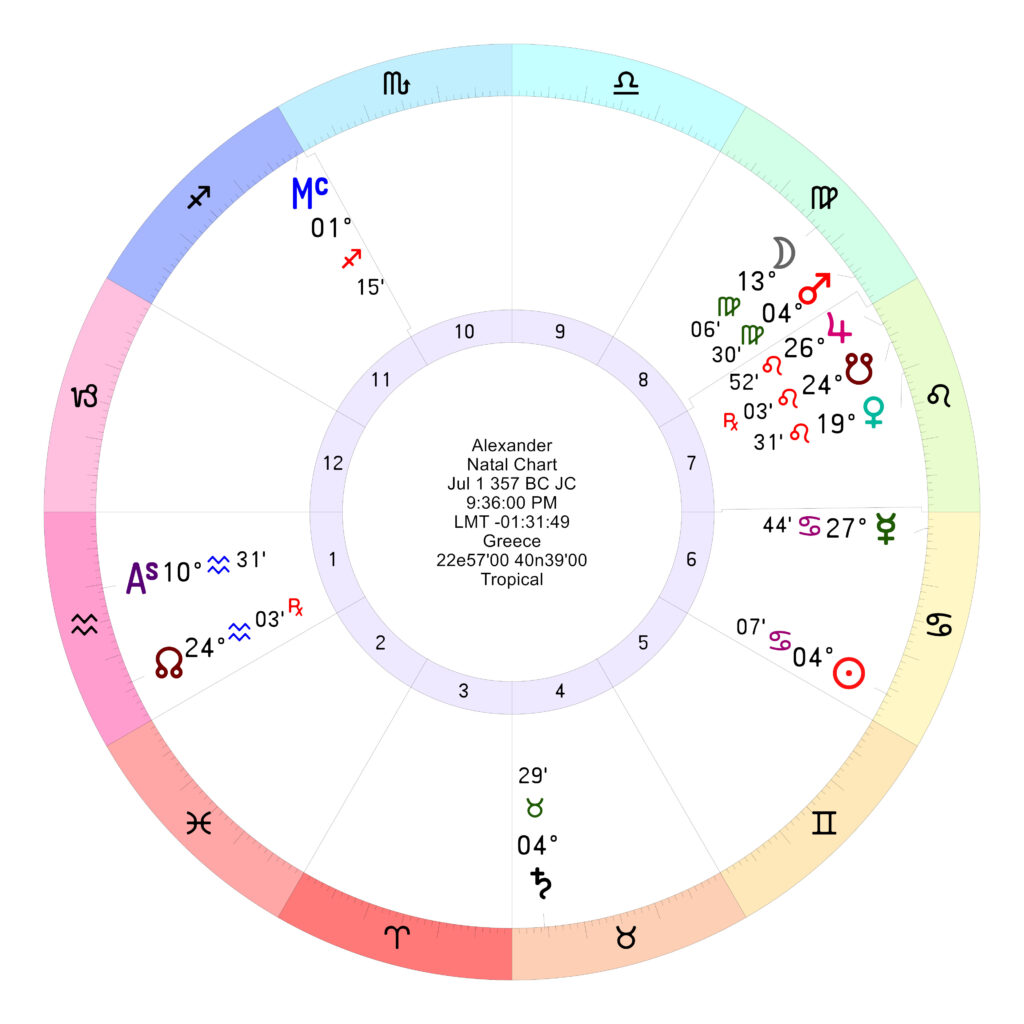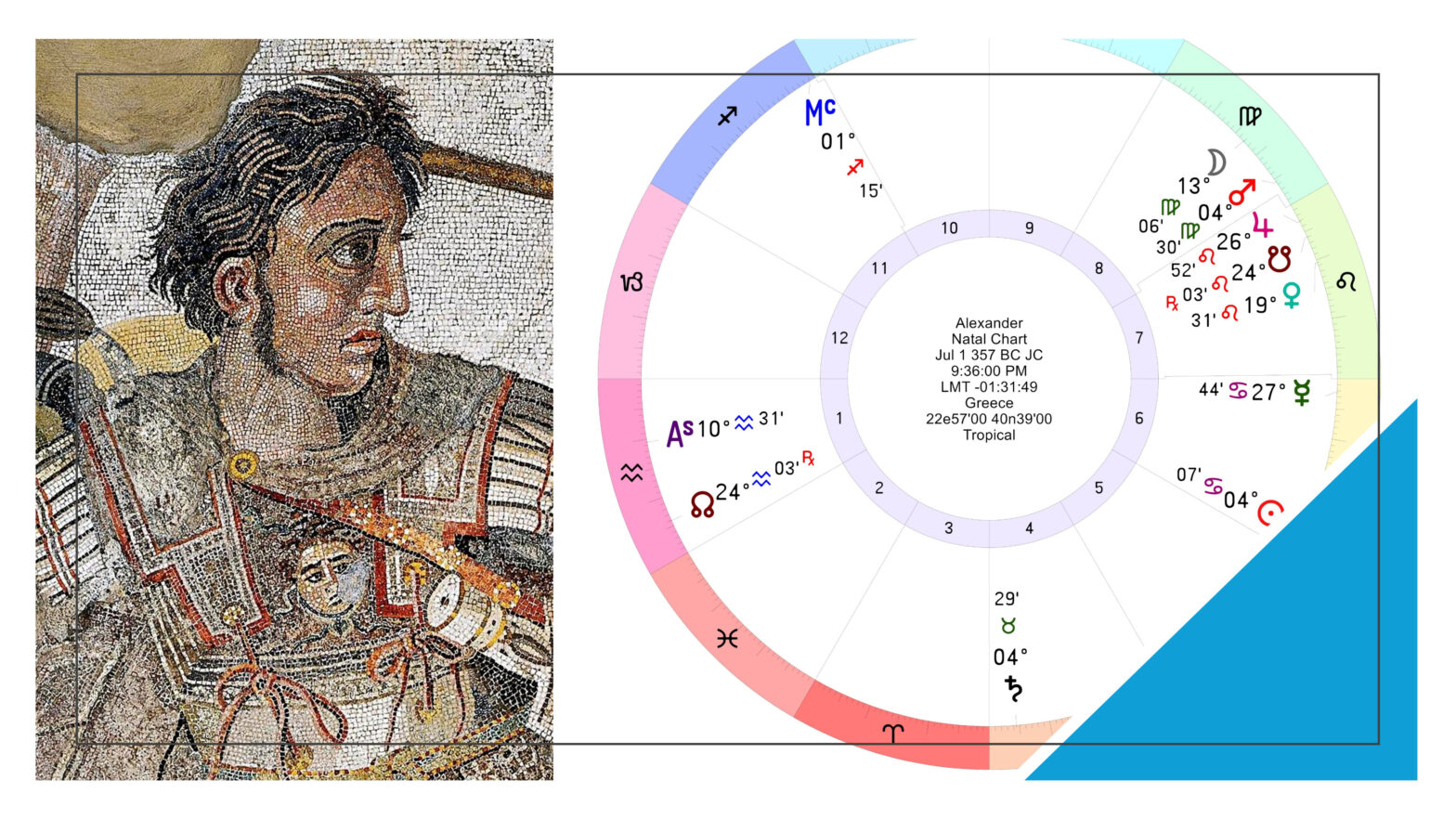Relying on the authority of Plutarch, we learn that this heroic and magnanimous prince, Alexander, was born of Philip, King of Macedon, and Olympias, a young maiden from the island of Samothrace. Although she later became Philip’s wife, Plutarch differs from Lyndholt concerning the time of Alexander’s birth. Plutarch records his nativity as occurring on the sixth day of the month Hecatombaeon (roughly July), whereas Lyndholt not only proposes but firmly asserts a different date, reflected in the figure below. However, setting aside chronological discrepancies, let us first examine how this nativity reflects the native’s physical form, temperament, and condition of mind—and then how it corresponds to two great events: his coronation and his death.
On His Form, Character, and Temperament

Alexander was said to be of medium stature—a fact well indicated by the position of the Lord of the Ascendant and the Luminaries in signs of short ascent (or brevity). Biographers also mention a peculiar feature: a stiff neck or a slight tilt of the head to one side. This physical quirk is clearly shown by Saturn’s placement in Taurus, in azimene and pitted degrees, while also being Lord of the Ascendant.
Now, according to Hermes, Venus enhances or beautifies the part of the body corresponding to the sign she occupies at birth. By the same logic, Saturn—being contrary to Nature—deforms the part of the body represented by his sign, especially when he is the Ascendant’s ruler and placed in such detrimental degrees as here.
Alexander was also known to be fiery in temperament and notably hairy. These traits are well testified by the Moon conjoined with Mars. His boundless ambition, martial courage, and greatness of spirit are powerfully shown by the North Node (Caput Draconis) rising at the Ascendant, with Saturn—its dispositor—trine the Moon and Mars. The Sun, positioned in the exaltation of Jupiter and forming harmonious aspects to all three, adds further confirmation. Altogether, the planetary configurations in this figure match the historical descriptions of his character, demeanor, and natural gifts.
On His Coronation and Death
Let us now turn to the events of his life. First, his coronation is strongly indicated by a direction of the Midheaven (MC) to the trine of Venus. Venus is conjunct, in a wide (platick) manner, with the benefic Jupiter in the seventh house—Jupiter being the Lord of the tenth house of rank and honor. This direction took place around his twenty-first year, aligning with the time when Alexander was crowned and received the royal diadem.
As for his death, the event is marked by a direction of the Moon to the square of Mercury, who rules the eighth house of death. This square occurred in the eighth house, in the sign of Libra. Meanwhile, Mercury—retrograde and positioned in Cancer in the sixth house—serves as the Anareta (the planet that destroys life), while the Moon is the Hyleg (the giver of life) in this nativity.
Astrologically, there is strong evidence to suggest that he was poisoned—even though Plutarch seeks to absolve that charge—for the fatal direction occurred in one of the most obscure houses of the chart (the eighth), and the Moon was joined to Mars in Mercury’s sign, while Mercury himself was retrograde in the sixth house. The matter seems even more certain considering that six years after his death, Olympias, his mother, uncovered the plot and had several individuals executed for their role in his demise.
From A Collection of Nativities, JOHN GADBURY
Commentary by Satya
Gadbury links Saturn—lord of the Ascendant—placed in Taurus to Alexander’s characteristic head posture (a slight tilt), and ties the Moon–Mars conjunction to his fiery, choleric temperament.
In primary directions, he associates Alexander’s accession with the Midheaven directed to a trine of Venus. Venus is with Jupiter, and Jupiter rules the Sagittarius Midheaven—an honor-granting configuration that fits his succession to Philip II in 336 BC at about age 20.
For the end of life, Gadbury treats Mercury (lord of the 8th) in the 6th as the anareta and the Moon as hyleg in a nocturnal chart, then links Alexander’s death to a direction of the Moon to Mercury. He notes the operation of this direction in the 8th house and reads the Moon–Mars connection (in a sign of Mercury) together with Mercury in Cancer in the 6th as testimony for a concealed or insidious cause. Here Mercury and the Moon are in mutual reception by domicile (Mercury in the Moon’s sign; the Moon in Mercury’s), strengthening the theme of hidden illness or plotting. Ancient reports suggest no immediate suspicion of poison; yet five or six years later Olympias punished several men, even desecrating the ashes of the cupbearer Iollas—just the kind of aftermath traditional astrologers associate with 6th/8th-house obscurity and intrigue.
Takeaway: Within a traditional framework, Saturn as lord of the Ascendant afflicting bodily significations, a hot Moon–Mars temperament, an honor-conferring MC–Venus/Jupiter direction near age 20, and a death pattern involving the Moon directed to Mercury (with testimonies in the cadent 6th and dark 8th) coherently map onto Alexander’s recorded rise and the long-debated circumstances of his demise.
